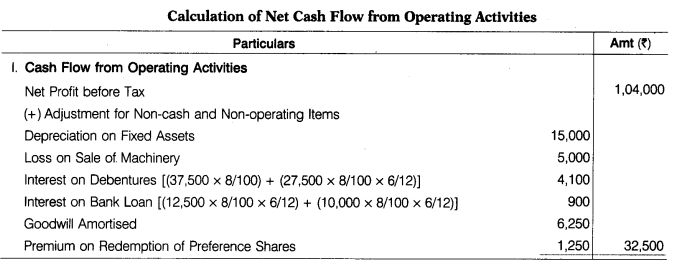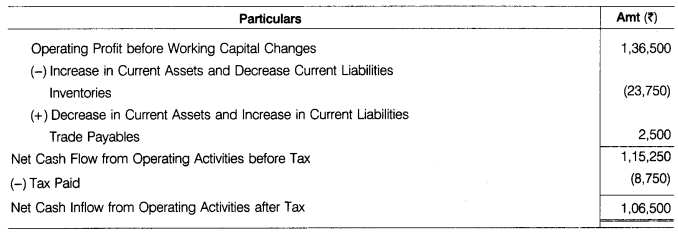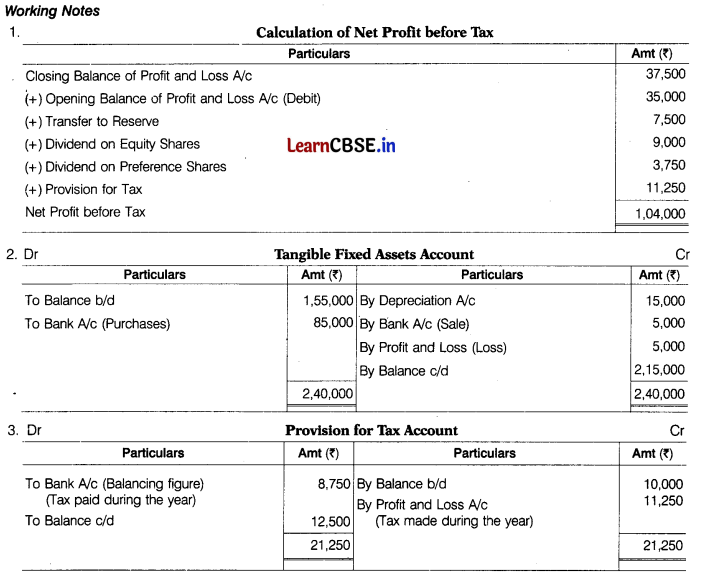Students must start practicing the questions from CBSE Sample Papers for Class 12 Accountancy with Solutions Set 4 are designed as per the revised syllabus.
CBSE Sample Papers for Class 12 Accountancy Set 4 with Solutions
Time :3 hrs
Max. Marks: 80
Instructions:
- This question paper contains 34 questions. All questions are compulsory.
- This question paper is divided into two parts, Part A and B.
- Part-A has Accounting for Partnership Firms and Companies.
- Part-B has Analysis of Financial Statements.
- Questions Nos. 1 to 16 and 27 to 30 carries 1 mark each.
- Questions Nos. 17 to 20, 31 and 32 carries 3 marks each.
- Questions Nos. from 21, 22 and 33 carries 4 marks each
- Questions Nos. from 23 to 26 and 34 carries 6 marks each
-
There is no overall choice. However, an internal choice has been provided in 7 questions of
one mark, 2 questions of three marks, 1 question of four marks and 2 questions of six marks.
Part A
(Accounting for Partnership Firms and Companies)
Question 1.
Interest on capital will be paid to the partner only out of if provided for in the partnership deed. [1]
(a) profits
(b) reserves
(c) accumulated profits
(d) goodwill
Answer:
(a) profits
Question 2.
Which of the following is correct in relation to admission of a new partner? [1]
(a) On admission of a new partner, old firm is dissolved
(b) On admission of a new partner old partnership is dissolved
(c) On admission of a new partner, both old partnership and firm are dissolved.
(d) On admission of a new partner, neither partnership nor firm is dissolved
Answer:
(b) On admission of a new partner, old partnership is dissolved
![]()
Question 3.
When debenture amount is received in lumpsum, …….. is credited with bank account. [1]
(a) debenture application and allotment account
(b) debenture account
(c) debenture allotment account
(d) None of the above
Or
Calculate the interest for the year 2021, when 6% debentures are issued for ₹ 20,00,000 of ₹ 100 each. [1]
(a) ₹ 1,60,000
(b) ₹ 1,20,000
(c) ₹ 12,000
(d) ₹ 12,00,000
Answer:
(a) debenture application and allotment account
Or
(b) Annual Interest = 20,00,000 x 6/100 = ₹ 1,20,000
![]()
Question 4.
A firm having the assets of ₹ 2,00,000 and liabilities of ₹ 84,000 earns the annual profit of ₹ 18,000. The rate of normal profit being 12%, the amount of goodwill by capitalisation of super profit method, will be ………. [1]
(a) ₹ 13,290
(b) ₹ 36,000
(c) ₹ 34,000
Answer:
(c) Normal Profit = (Assets – Liabilities) x Normal
Rate of Return =2,00,000-84,000 x 12/100
= ₹ 13,920
Super Profit = Average Profit – Normal Profit
=18,000-13,920 = ₹ 4,080
Goodwill = Super Profit x \(\frac{100}{\text { Normal Rate of Return }}\)
= 4,080 x \(\frac{100}{12}\) = ₹ 34,000
Question 5.
Assertion (A) At the time of change in profit sharing ratio, it is important to determine the sacrificing ratio and gaining ratio.
Reason (R) At the time of change in profit sharing ratio, gaining partner compensates the sacrificing partner by paying him proportionate amount of goodwill. [1]
Alternatives
(a) Both Assertion (A) and Reason (R) are true and Reason (R) is the correct explanation of Assertion (A)
(b) Both Assertion (A) and Reason (R) are true, but Reason (R) is not the correct explanation of Assertion (A)
(c) Assertion (A) is true, but Reason (R) is false
(d) Assertion (A) is false, but Reason (R) is true
Answer:
(a) Both Assertion (A) and Reason (R) are true and Reason (R) is the correct explanation of Assertion (A)
![]()
Question 6.
If equal amount is withdrawn by a partner at the end of each month during a period of 6 months, interest on the total amount will be charged for months. [1]
(a) 2.5
(b) 3
(c) 3.5
(d) 6
Or
A partner withdraws ₹ 1,600 each on 1st April and 1st October. Interest on his drawings @ 6% p.a. on 31st March will be …………..
(a) ₹ 96
(b) ₹ 144
(c) ₹ 48
(d) ₹ 192
Answer:
(a) 2.5
Or
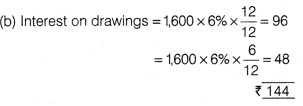
Question 7.
If a partner withdraws equal amount at end of each quarter, then are to be considered for interest on total drawings. [1]
(a) 5.5 months
(b) 6 months
(c) 4.5 months
(d) 7.5 months
Answer:
(c) Time Period
Time Left after First Drawings
= \(\frac{+ \text { Time Left after Last Drawings }}{2}\)
= \(\frac{9+0}{2}\) = 45 months
![]()
Question 8.
V, S and T are partners in a firm with profit sharing ratio 3: 2: 1 respectively. The extract of their Balance Sheet is as follows. [1]

At the time of retirement of T, if liability for workmen compensation to the extent of 24,000 is to be created, then at what amount will workmen compensation reserve be shown in new balance sheet? [1]
(a) 48,000
(b) 72,000
(c) 24,000
(d) Not to be shown in new balance sheet
Or
X and Y are partners in a firm sharing profits and losses in the ratio of 5: 1.

If value of machinery in the balance sheet is undervalued by 20%, then at what value will machinery be shown in new balance sheet?
(a) 4,400
(b) 4,800
(c) 3,200
(d) 5,000
Answer:
(c) Workmen compensation reserve to the extent of liability i.e. ₹ 24,000 is credited to workmen compensation claim account and the balance is credited to partners’ capital accounts.
Or
(d) \(\frac{4,000}{80}\) x 100 = ₹ 5,000
Direction Read the following hypothetical situation and answer Q. No. 9 and 10
Goldee Limited was incorporated on 1st April, 2020 with registered office in Ahmedabad. The capital clause of memorandum of association reflected a registered capital of ₹ 2,00,000 equity shares of ₹ 10 each and 25,000 preference shares of ₹ 50 each. Since some large investments were required for building and machinery, the company in consultation with vendors, M/s Sultan Ltd. issued 25,000 equity shares and 5,000 preference shares at par to them in full consideration of assets acquired. Besides this the company issued 50,000 equity shares for cash at par payable as ₹ 3 on application, ₹ 2 on allotment, ₹ 3 on first call and ₹2 on second call. Till date, second call has not yet been made and all the shareholders have paid except Rishant who did not pay allotment and calls on his 75 shares and Sonu who did not pay first call on his 50 shares. Shares of Rishant were then forfeited and out of them 25 shares were reissued at ₹ 12 per share.
Question 9.
How many equity shares of the company have been subscribed? [1]
(a) 75,000
(b) 71,875
(c) 74,950
(d) None of these
Answer:

![]()
Question 10.
The amount of security premium reflected in the balance sheet at the end of the year will be … [1]
(a) ₹ 50
(b) ₹ 150
(c) ₹ 100
(d) ₹ 250
Answer:
(c) Securities premium reflected in the balance sheet at the end of the year will be ₹ 100(25 x 4).
Question 11.
A shareholder to whom 9,000 shares of ₹ 10 per share allotted, failed to pay first and final call of ₹ 2 per share. How will it be recorded in the books of company? [1]
(a) ₹ 18,000 will be debited to calls-in-arrear account
(b) ₹ 18,000 will be debited to share forfeiture account
(c) ₹ 18,000 will be credited to calls-inarrear account
(d) ₹ 18,000 will be credited to share forfeiture account
Or
If vendors are issued fully paid shares of ₹ 1,00,000 in consideration of net assets of ₹ 1,20,000, the balance of ₹ 20,000 will be ……………… [1]
(a) credited to goodwill account
(b) credited to capital reserve account
(c) credited to vendor’s account
(d) credited to profit and loss account
Answer:
(a) ₹ 18,000 will be debited to calls-in-arrear account
Or
(b) credited to capital reserve account
Question 12.
X, Y and Z are partners sharing profits in the ratio of 3: 3: 2. As per the partnership agreement, Z is to get a minimum amount of ₹ 8,000 as his share of profits every year and any deficiency on this account is to be personally borne by X. The net profit for the year ended 31st March, 2021 amounted to ₹ 31,200. Calculate the amount of deficiency to be borne by X. [1]
(a) ₹ 100
(b) ₹ 400
(c) ₹ 800
(d) ₹ 200
Answer:
(d) Net profit for the year = ₹ 31,200
Z’s share in profits = 31,200 x 2/8 = ₹ 7,800
Guaranteed to Z = ₹ 8,000
Deficiency to be borne by Z=8,000 – 7,800 = ₹ 200
![]()
Question 13.
A and B are two partners sharing profits in the ratio of 2: 1. C, a new partner admitted for 1/4th share. At the time of admission loss from revaluation is 9,000. Pass a necessary journal entry for distribution of loss between the partners. [1]
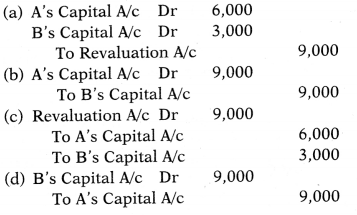
Or
Jhunjhun, a partner paid loan of the firm of ₹ 1,00,000 at the time of dissolution. Pass the journal entry for this transaction. [1]
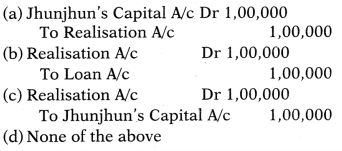
Answer:

Question 14.
P and Q are partners in the ratio of 3: 2. Their capitals are ₹ 10,000 and ₹ 5,000 respectively. Interest on capitals is allowed (a) 8% p.a. Firm incurred a loss of ₹ 3,000 for the year ended 31st March, 2021. Interest on capital will be.. [1]
(a) P ₹ 800 ; Q ₹ 400
(b) P ₹ 400; Q ₹ 200
(c) P ₹ 720 ; Q ₹ 480
(d) No interest will be allowed
Answer:
(d) In case of loss, no interest on capital is allowed unless it is treated as charge.
Question 15.
Which of the following is/are method(s) of valuation of goodwill? [1]
(i) Average profit method
(ii) Super profit method
(iii) Capitalisation method
Codes
(a) Only (i)
(b) (i) and (ii)
(c) (ii) and (iii)
(d) (i), (ii) and (iii)
Answer:
(d) (i), (ii) and (iii)
![]()
Question 16.
Assertion (A) Equity shares are those shares which are not preference shares. Reason (R) Equity shares are the least issued class of shares and carries the minimum risk and rewards of the business. [1]
Alternatives
(a) Both Assertion (A) and Reason (R) are true and Reason (R) is the correct explanation of Assertion (A)
(b) Both Assertion (A) and Reason (R) are true, but Reason (R) is not the correct explanation of Assertion (A)
(c) Assertion (A) is true, but Reason (R) is false
(d) Assertion (A) is false, but Reason (R) is true
Answer:
(c) Equity shares are the most commonly issued class of shares and carries the maximum risk and rewards of the business.
Question 17.
Complete the missing information [1]

Or
RV Corp. Ltd. issued 40,000 equity shares of 10 each at a premium of 2 payable along with the application. All the shares were applied and duly allotted. Pass necessary journal entries.
Answer:
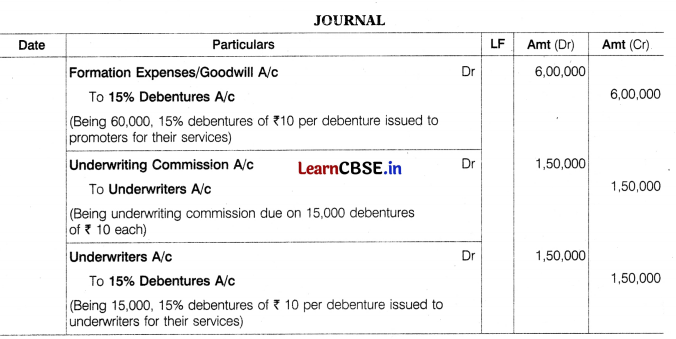
Or

Question 18.
The partnership agreement between Maneesh and Girish provides that
(i) Profits will be shared equally.
(ii) Maneesh will be allowed a salary of ₹ 400 per month.
(iii) Girish who manages the sales department will be allowed a commission equal to 10% of the net profits, after allowing Maneesh’s salary.
(iv) 7% interest will be allowed on partners’ fixed capital.
(v) 5 % interest will be charged on partners’ annual drawings.
(vi) The fixed capitals of Maneesh and Girish are ₹ 1,00,000 and ₹ 80,000 respectively. Their annual drawings were ₹ 16,000 and ₹ 14,000 respectively. The net profit for the year ending 31st March, 2006 amounted to ₹ 40,000.
Prepare firm’s profit and loss appropriation account. [3]
Answer:
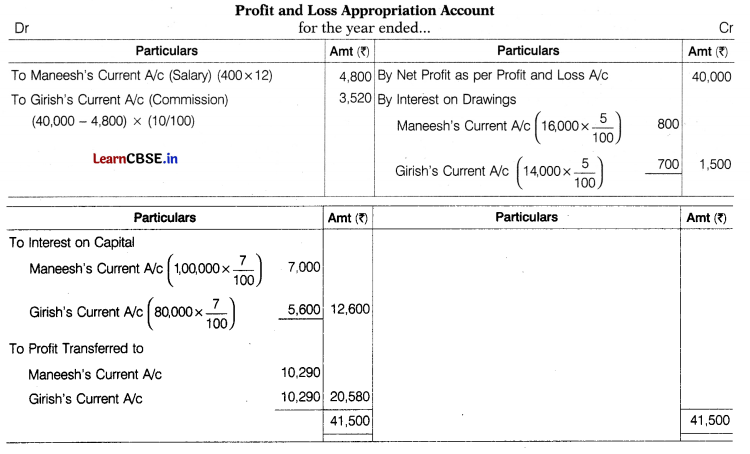
![]()
Question 19.
A, B and C are partners. Their capitals as on 1st April, 2023 were A ₹ 1,00,000, B ₹ 2,00,000 and C ₹ 3,00,000. Profits for the year 2022-2023 amounting to ₹ 1,20,000 were distributed in the ratio of capitals without providing for the following. [3]
(i) Interest on capitals A ₹ 10,000, B ₹ 20,000, C ₹ 30,000.
(ii) Interest on drawings A ₹ 6,000, B ₹ 10,000, C ₹ 16,000.
(iii) A’s salary of ₹2,000 per month and B’s commission of ₹ 8,000
The partnership deed was silent as to the sharing of profits and losses. Pass the necessary single adjusting entry.
Answer:
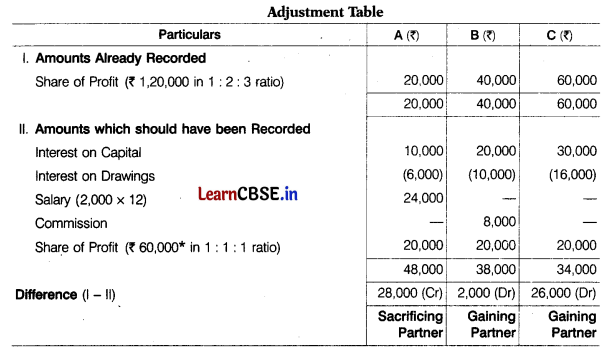
Revised profits =1,20,000-10,000-20,000-30,000+6,000+10,000+16,000-24,000-8,000=₹ 60,000
Question 20.
Surender, Ramesh, Naresh and Mohan are partners in a firm sharing profits in 2: 1: 2: 1 ratio. On the retirement of Naresh, the goodwill was valued at ₹ 2,16,000. Surender, Ramesh and Mohan decided to share future profits equally. Pass the necessary journal entry for the treatment of goodwill without opening good will account. [3]
Or
X, Y and Z are partners sharing profits in the ratio of 4: 3: 2. On 1st April, 2023, Y gave a notice to retire from the firm. X and Z decided to share future profits in the ratio of 1: 1. The capital accounts of X and Z after all adjustments showed a balance of ₹ 21,500 and ₹ 40,250 respectively. The total amount to be paid to Y was ₹ 47,750. This amount was to be paid by X ₹ 33,250 and by Z ₹ 14,500. Pass necessary journal entries in the books of the firm for the above transactions. Show your working clearly.
Answer:

Working Note
Calculation of Gaining Ratio
Gaining Ratio = New Share – Old Share
Surender = \(\frac{1}{3}-\frac{2}{6}=\frac{2-2}{6}=\frac{0}{6}\)=0;
Ramesh =\( \frac{1}{3}-\frac{1}{6}=\frac{2-1}{6}=\frac{1}{6}\) ;
Mohan = \(\frac{1}{3}-\frac{1}{6}=\frac{2-1}{6}=\frac{1}{6}\)
Gaining ratio of Ramesh and Mohan =1: 1
Naresh’s share of goodwill =2,16,000 x \(\frac{2}{6}\) = ₹ 72,000
Question 21.
Pass the necessary journal entries for the following transactions on the dissolution of firm of Pia, mathrm {Ria} and Tia (who were sharing profits in the ratio of 2: 2: 1 ) after the transfer of all assets (other than cash) and external liabilities to realisation account. [4]
(i) Debtors were of ₹ 31,050. Pia takes over debtors amounted to ₹ 30,000 at ₹ 29,300 and the remaining debtors were sold to a debt collecting agency at 50% of the value.
(ii) Sundry assets were of ₹ 29,250. Ria is to take over some sundry assets at ₹ 18,000 (being 10 % less than the book value). Tia is to take over remaining sundry assets at 80 % of the book value.
(iii) Tia assumes the responsibility of discharge of Mr. Tia’s loan of ₹2,875 together with accrued interest of ₹ 575.
Answer:

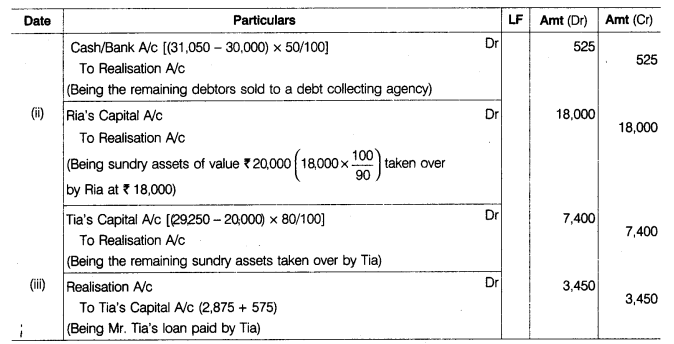
![]()
Question 22.
Kumar Ltd. purchased assets of ₹ 6,30,000 from Bhanu Oil Ltd. Kumar Ltd. issued equity shares of ₹ 100 each fully paid in consideration. What journal entries will be made, if the shares are issued (i) at par and (ii) at premium of 20%. [4]
Answer:
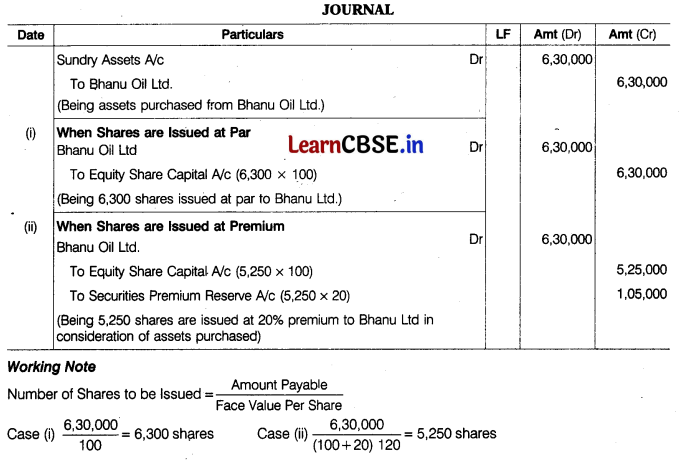
Question 23.
Vijay Pvt. Ltd. issued 10,000,9 % debentures of ₹ 100 each to the public at 10 % discount on 1st April, 2022. These debentures are redeemable after 6 years at a premium of 10%. Pass the necessary journal entries for issue of debentures and writing-off ‘loss on issue of debentures’ in same year of issue, if company has a balance of ₹ 80,000 in its securities premium reserve account and also prepare loss on issue of debentures account. [6]
Answer:
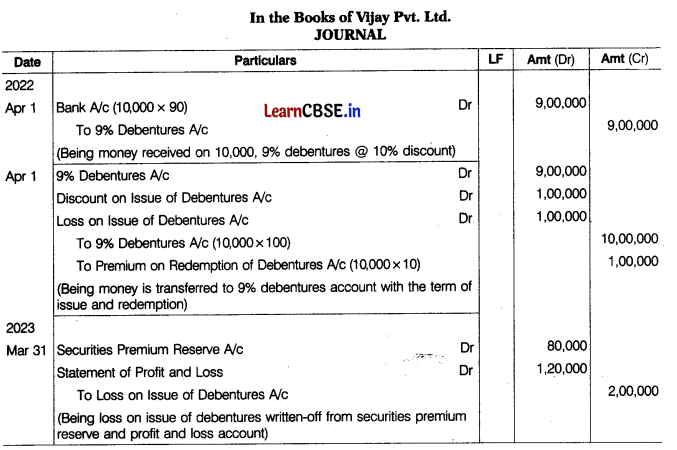
Working Note
Total loss on issue of debentures account = Discount on issue of debentures + Premium on redemption of debentures account
=1.00,000 + 1,00,000 = 2,00,000.

Question 24.
The balance sheet of A, B and C, who were sharing profits in the ratio of 5: 3: 2 as at 31st March, 2023 was as follows
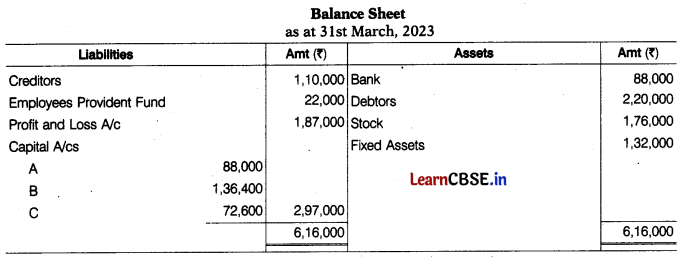
A retired on 31st March, 2023. It was agreed that: [6]
(i) Goodwill of the firm was valued ₹ 1,76,000.
(ii) Fixed assets are to be depreciated by ₹ 5,500
(iii) Make a provision for doubtful debts at 5% on debtors.
(iv) New profit sharing ratio of B and C will be 2: 3.
(v) A liability for claim, included in creditors for ₹ 22,000 is settled at ₹ 17,600.
![]()
The amount to be paid to A ₹ 2,63,450 and to B ₹ 4,510 and cash brought in by C ₹ 2,12,960 by leaving a balance of ₹ 33,000 in the bank.
Prepare revaluation account and partners capital account.
Or
X and Y were partners in a firm sharing profits in the ratio of 3: 2. On 1st April, 2022, they admitted Z as a partner in the firm. The balance sheet of X and Y on that date was as under:
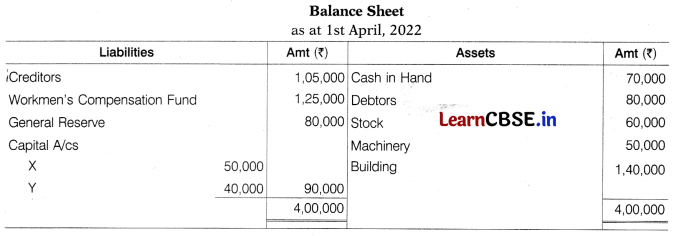
It was agreed that
(i) The value of building and stock be appreciated to ₹ 1,90,000 and ₹ 80,000 respectively.
(ii) The liabilities of workmen’s compensation fund was determined at ₹ 1,15,000.
(iii) Z brought in her share of goodwill ₹ 50,000 in cash.
(iv) Z was to bring cash ₹ 60,000 as his capital.
(v) The future profit sharing ratio will be X 2/5th, Y 2/5th and Z 1/5th.
Prepare revaluation account, partners’ capital accounts and balance sheet of the new firm.
Answer:
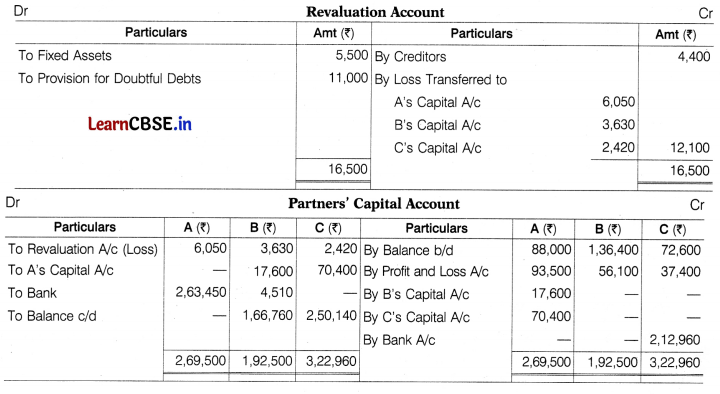
Working Notes
1. Calculation of Gaining Ratio
Gaining Ratio = New Ratio – Old Ratio
B = \(\frac{2}{5}-\frac{3}{10}=\frac{4-3}{10}=\frac{1}{10}, \mathrm{C}=\frac{3}{5}-\frac{2}{10}=\frac{6-2}{10}=\frac{4}{10}\) ⇒ Gaining ratio = 1: 4
phrase:
Or
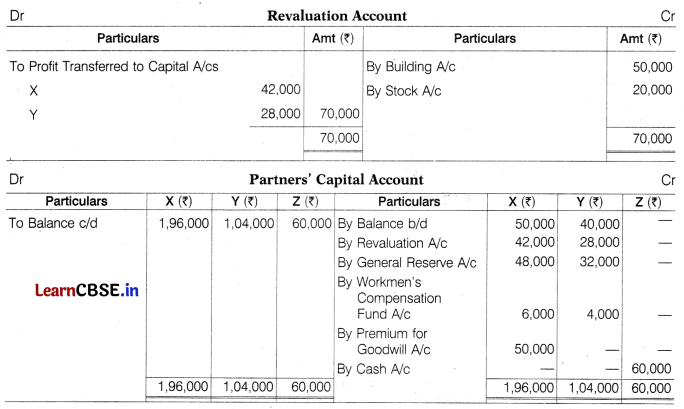
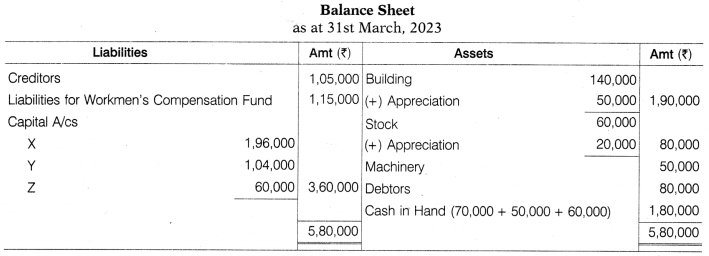
Working Note
Calculation of Sacrificing Ratio
Sacrificing Ratio = Old Share – New Share
X = \(\frac{3}{5}-\frac{2}{5}=\frac{3-2}{5}=\frac{1}{5}\) ;
Y = \(\frac{2}{5}-\frac{2}{5}=\frac{2-2}{5}\) = Nil
Here, the entire sacrifice has been made by X.
![]()
Question 25.
Raja Ltd. invited applications for 1,00,000 equity shares of ₹ 10 each. The shares were issued at a premium of ₹ 5 per share. The amount was payable as follows On application and allotment ₹ 8 per share (including premium ₹ 3).
The balance including premium on the first and final call.
Applications for 1,50,000 shares were received. Applications for 10,000 shares were rejected and pro-rata allotment was made to the remaining applicants on the following basis
(i) Applicants for 80,000 shares were allotted 60,000 shares.
(ii) Applicants for 60,000 shares were allotted 40,000 shares.
P, who belonged to the first category and was allotted 300 shares, failed to pay the first call money.
Q, who belonged to the second category and was allotted 200 shares, also failed to pay the first call money. Their shares were forfeited. The forfeited shares were re-issued @ ₹ 12 per share fully paid-up. Pass necessary journal entries and prepare cash book. [6]
Or
On 1st June, 2022, Kartik Ltd. offered for subscription 50,000 equity shares of ₹ 100 each at a premium of ₹ 20 per share payable as given below
On application ₹ 20 per share, on allotment (including premium) ₹ 50 per share and two months after allotment ₹ 50 per share.
Applications were received for 84,000 shares. On 1st July, 2022, the Directors proceeded to allot shares proportionately. Of these, application for 4,500 shares were accompanied with full amount and hence, were accepted in full and the balance allotment was made on pro-rata basis. Excess amount paid by applicants was utilised towards allotment and call money due from them. One of the applicants to whom 300 shares were allotted proportionately, failed to pay the call money. His shares were forfeited on 30th November, 2022 and subsequently issued @ ₹ 130 per share. Record entries relating to these transactions in the journal of the company.
Answer:
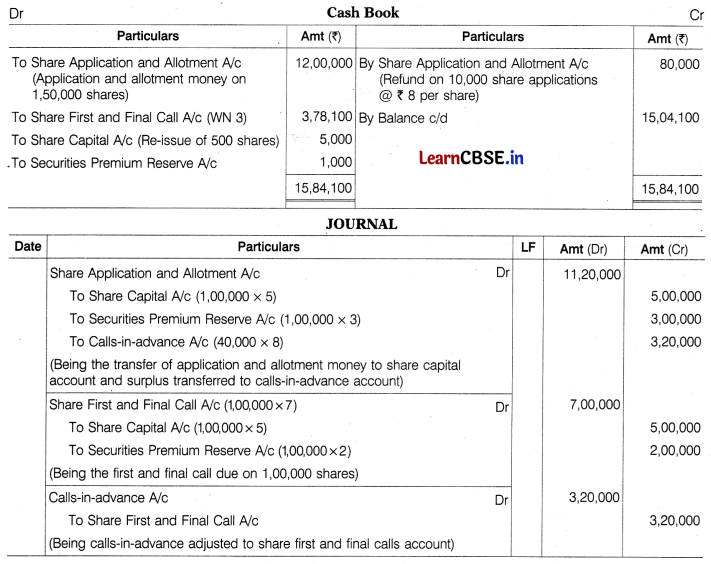
Working Notes
1. Number of shares applied by P=80,000 / 60,000 x 300 = 400 shares Number of shares applied by
Q = 60,000 / 40,000 x 200=300 shares
2. The surplus application and allotment money paid by P and Q which is adjusted on the first and the final call
= 200 x 8 = ₹ 1,600.
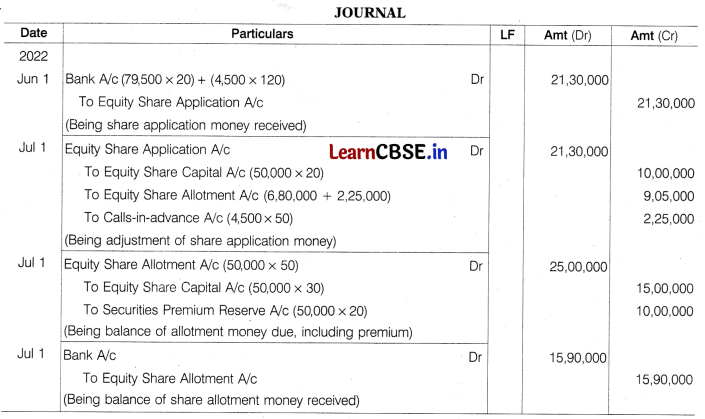
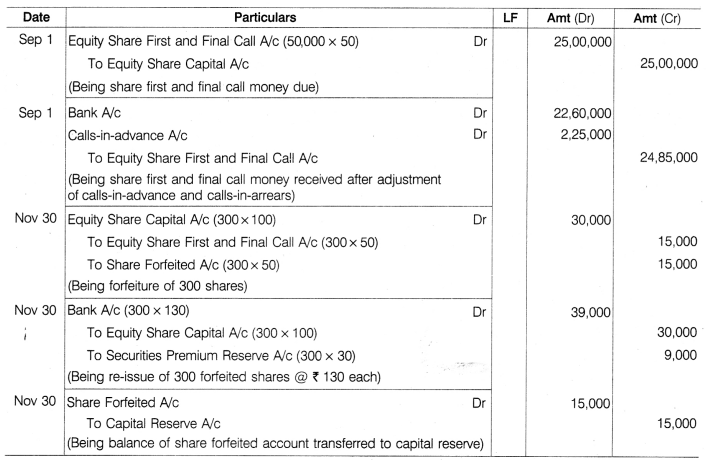
Working Note:

![]()
Question 26.
Ishu and Nishu are partners sharing profits and losses in the ratio of 2: 1. On 31st December, 2022, the partners decided to dissolve the firm. Their balance sheet is as follows.
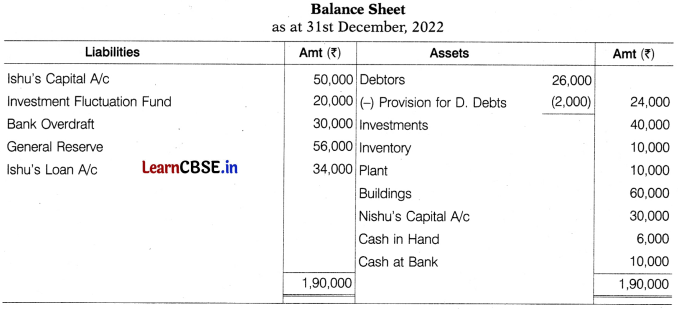
The assets were realised as follows Debtors ₹ 26,000, Inventory ₹ 8,500, Plant ₹ 8,000, Buildings ₹ 1,00,000. Investment were taken over by Ishu at ₹ 35,000. Compensation was paid to employees ₹ 10,000. Prepare realisation account, partners’ capital account and bank account. [6]
Answer:
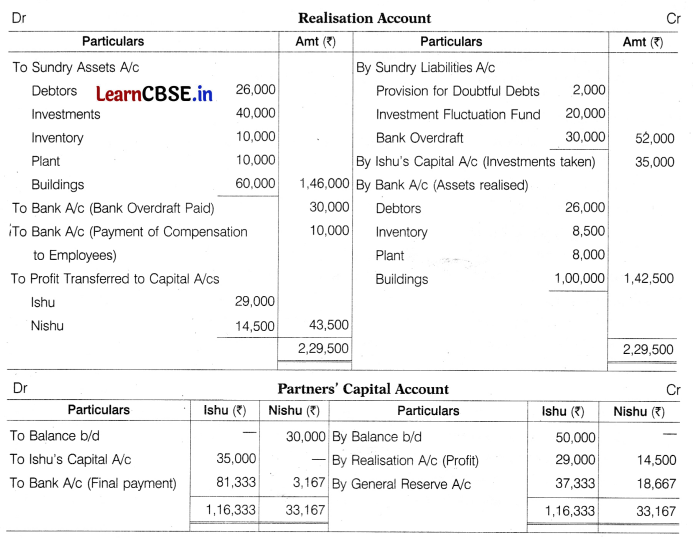

PartB
(Financial Statement Analysis)
Question 27.
Which of the following is a non-operating income? [1]
(a) Dividend received by an investment company
(b) Premium received by an insurance company
(c) Revenue from sale in a trading concern
(d) Profit on the sale of used plant in manufacturing company
Or is a highly liquid investment.
(a) Cash convertible investment
(b) Cash equivalent
(c) Short-term investment
(d) Long-term investment
Answer:
(d) Manufacturing companies use plant and machinery to produce goods. but they do not deal in plant and machinery. So, profit on sale of an asset is a non-operating income.
Or
(b) Cash and cash equivalents are short-term highly liquid investments that are readily convertible into known amount of ‘cash and which is subjected to an insignificant risk of changes in value.
![]()
Question 28.

Additional Information
50% of the debentures are repaid by issuing shares amounting to ₹ 3,00,000. Based on the above information, the liquid ratio for the company will be …………. [1]
(a) 1: 1
(b) 0.47: 1
(c) 2: 1
(d) 1: 2
Answer:
(b) \(\frac{\text { Liquid Assets }}{\text { Current Liabilities }}=\frac{3,60,000+91,200}{9,36,000+24,000}=\frac{4,51,200}{9,60,000}\) = 0.47 : 1
Since, debentures are repaid by issuing same amount of shares thus, their is no effect on cash balance of the company.
Question 29.
From the following information, you are required to calculate cost of material consumed. Opening inventory of materials ₹30,00,000; Opening stock-in-trade ₹ 8,00,000; Material purchased ₹1,00,00,000; Purchase of stock-in trade ₹ 60,00,000; Closing inventory of material ₹ 10,00,000 and Closing inventory of stock ₹ 6,00,000. [1]
(a) ₹ 60,00,000
(b) ₹ 1,20,00,000
(c) ₹ 80,00,000
Answer:
(b) Cost of Material Consumed = Opening Inventory + Materials Purchased – Closing Inventory of Material
= 30,00,000+1,00,00,000-10,00,000 = ₹ 1,20,00,000
Question 30.
Which of the following is not an financing cash flow? [1]
(a) Issue of debentures for cash
(b) Dividend paid on equity shares
(c) Purchase of investment for cash
(d) Both (a) and (b)
Or
Statement I Cash proceeds from issue of shares will result in inflow of cash. Statement II Interest paid on borrowings will result into outflow of cash.
Alternatives
(a) Both the statements are true
(b) Both the statements are false
(c) Statement I is true and Statement II is false
(d) Statement II is true and Statement I is false
Answer:
(c) Purchase of investment for cash
Or
(a) Both the statements are true
![]()
Question 31.
Name any three items that can be disclosed under non-current investments. [3]
Answer:
The items that can be disclosed under non-current investments are (any three)
- Investment in equity instruments
- Investment in mutual funds
- Investment in debentures or bonds
- Investment in property
Question 32.
Prepare a comparative statement of profit and loss of XYZ Ltd., with the help of the following information [3]

Answer:
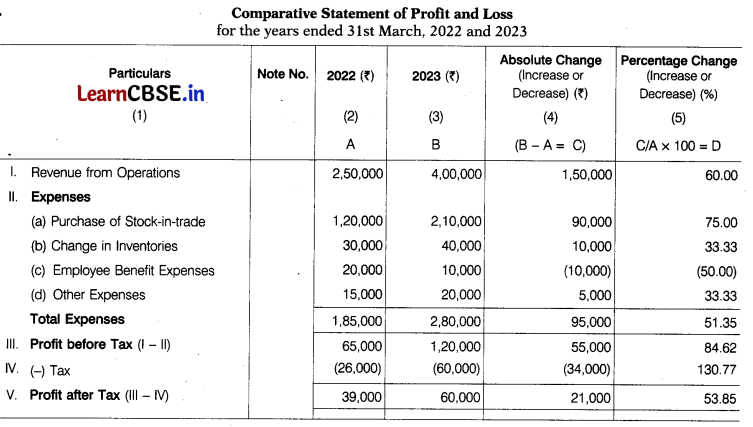
Question 33.
Calculate value of opening stock and closing stock from the following information Sales ₹ 5,00,000, gross profit is 20% of net sales, return inward is ₹ 20,000, return outward is ₹ 50,000, purchases ₹ 2,50,000 and opening stock is 2 times of the closing stock. [4]
Answer:

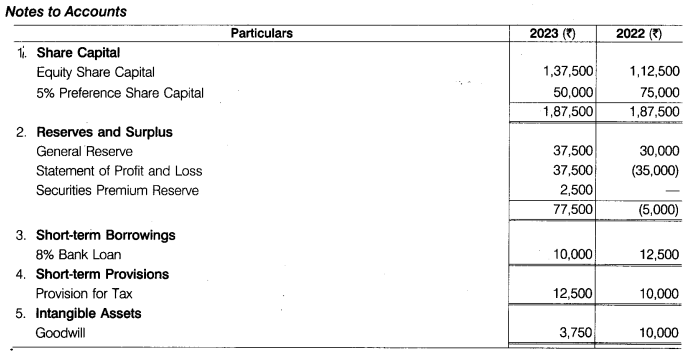
Additional Information
During the year, a piece of machinery costing ₹ 15,000 on which depreciation charged was ₹ 5,000 was sold for ₹ 5,000. Depreciation provided on fixed assets ₹ 15,000. Dividend on equity shares @ 8% was paid on opening balance. Income tax ₹ 11,250 was provided. Additional debentures were issued at par on 1st October, 2022 and bank loan was repaid on the same date. At the end of the year, preference shares were redeemed at a premium of 5 %. [6]
Answer:
